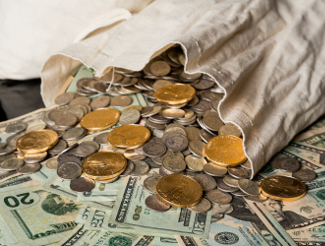The first quarter of 2020 was one of the worst ever for the Dow Jones and the S&P 500. And the first trading day of the second quarter saw the worst ever start for both indices, worse even than the worst days of the Great Depression. With stock markets thousands of points below their recent highs, many investors fear that the worst is yet to come, and that markets could see a repeat of the 2008 financial crisis, during which markets lost over 50% of their value.
A loss of that magnitude would essentially wipe out over a decade worth of gains, sending markets back to where they were before the 2008 crisis. For many investors who stick to a buy and hold strategy, that could cost them dearly, forcing them to endure paper losses of a tremendous magnitude. And for those investors nearing retirement, they may not be able to make up those losses in time before they retire.
With all that in mind, many investors worry about what to invest in in order to keep their assets safe. It’s only been in the past four years that stock markets have once again been seen as a certain win, so damaged were investors by the 2008 crisis. And with markets looking to crash even further, investors are wondering where to park their money so that it won’t lose value. Here are five investment alternatives that many investors choose.
1. Cash
Cash isn’t the ideal investment, at least not for the long term. With inflation nearly certain, particularly as the Federal Reserve continues to pump trillions of dollars of liquidity into the financial system, holding cash is guaranteed to lose you money. But for the short term it can be just fine.
Many wealthy investors are already fleeing to cash, withdrawing money from their bank accounts and hiding it under the proverbial mattress. If you fear a breakdown of the banking system, it isn’t necessarily a bad idea to have some cash on hand. But have too much cash and you could attract the attention of law enforcement agencies. Even banks don’t like to deal with large bundles of cash, so if you pull out tens of thousands of dollars from your bank, you’d better have a receipt for it, otherwise your bank (and the federal government) might start asking questions about where all that money came from.
2. Money Market Funds
Money market funds are often treated like cash or bank deposit equivalents, but they’re actually more like a mutual fund. They invest in short-term, highly rated securities, then issue shares to depositors. Each share is valued at $1, and funds invest in order to maintain that par value.
The danger with money market funds is that in times of financial crisis they can “break the buck,” i.e. the share price drops below $1. When that happens, investors who hold shares in these normally staid funds begin to panic and liquidate their holdings. That pushes share values down even further below $1, causing a run on funds that can become systemic.
That was the case in 2008, which is why the Federal Reserve created the Asset-Backed Commercial Paper Money Market Mutual Fund Liquidity Facility (AMLF) back then, after a money market fund collapsed. This time around, the Fed has created the Money Market Mutual Fund Liquidity Facility (MMLF) to prop up money market funds, which are under intense selling pressure from institutional investors looking to get cash. So while money market funds might be a good place to park assets in the short term, their potential risk during times of crisis means that they’re not the best choice for long-term investment.
3. US Treasury Securities
US Treasury Securities are the benchmark by which all other bonds are judged. And when times get tough, many investors seek to purchase them, thinking they are the safest asset around. The thinking goes that the US government has never defaulted on a bond, so US Treasuries are safe. Of course, that’s not exactly true.
The US has defaulted on bonds before, most notably the fourth installment of the Liberty bonds in 1934. Those bonds were supposed to be repayable in gold coin, but the government not only refused to pay in gold, it also refused to make investors whole for the devaluation of the dollar from $20.67 per ounce of gold to $35 per ounce of gold, thus sticking investors with a 40% real loss on their principal.
With the federal government set to issue trillions more dollars of debt in the coming years through its stimulus spending, the supply of US Treasury bonds outstanding will swell tremendously. Whether there will be enough demand for all that debt is questionable, as everyone assumes the Fed will monetize most of it.
Yields on Treasury securities are also abysmal right now, near zero on the shortest-term bonds. If you’re holding short-term Treasuries to maturity, there’s really not that much difference now between parking your money in a bank account and holding Treasury securities.
4. Gold
Gold has been the traditional safe haven of choice for investors looking to protect themselves against stock market crashes. When bear markets rear their head, gold generally performs quite well.
Gold has taken a mild hit so far this spring, although it’s still up for the year. But with so many investors looking to drum up cash, gold markets have been relatively choppy. That gives a good opportunity to many investors to buy on the dips so that they can enjoy gains in the future.
In 2008, gold declined along with stock markets through the worst part of the crisis, then took off as a safe haven asset once investors realized that the Great Recession was real. It nearly tripled in value over the next few years, inspiring many an investor to hold gold. If its performance during the coming recession ends up being similar, gold at $2,000 an ounce should be well within reach, and even $3,000 an ounce isn’t out of the question a few years down the road.
5. Silver
Silver has taken a little bigger beating than gold through the latest market turbulence, due to the fact that about 50% of silver’s demand comes from industry. With industrial demand slowing, silver prices have remained subdued. That makes for a great buying opportunity for investors looking to capitalize on future price gains on their safe haven assets.
By most normal measurements, silver should really be trading closer to $20 an ounce rather than $15 an ounce. Once investor demand picks up later this year, the silver price can be expected to climb rather dramatically. From 2008 onward, silver nearly quadrupled in price, nearing $50 an ounce at one point. If it performs similarly during the next recession, expect those prices to be pretty easily attainable.
Precious metals such as gold and silver are also able to be invested in through a gold IRA or silver IRA. Investors can even roll over existing retirement assets from a 401(k), 403(b), IRA, or TSP accounts into a gold or silver IRA, without tax consequences. Whereas cashing out your retirement accounts would result in potential tax liabilities, a 401(k) to gold IRA rollover can be done easily without requiring any taxes to be paid to IRS. That allows investors to maintain the use of their existing retirement savings, continue to enjoy the tax advantages of an IRA, and benefit from the wealth protection offered by gold and silver.
This article was originally posted on Goldco.



